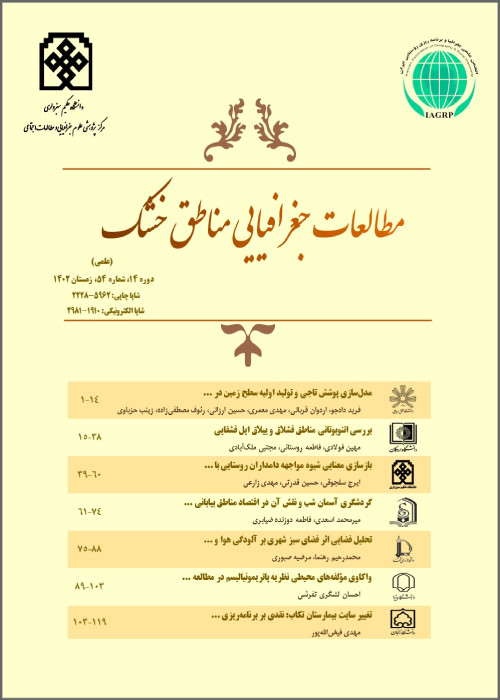Evaluation and zoning of the abandoned aqueduct in Sabzevar city
Author(s):
Article Type:
Research/Original Article (دارای رتبه معتبر)
Abstract:
Sabzevar city has a dry and cold climate and hot summers. Not a long time ago, in this city, the agricultural and drinkable water was gained from aqueducts. Aqueduct is one of the oldest and the most economic ways of the extraction of ground water in Iran. Within the city limits, there are 12 aqueducts named: Afzal-Abaad, Haaj-Abbas, Fath-Abaad, Haaj-Molla, Jafar-Abaad, Neqabashk, Saaleh-Abaad, Sanjar-Abaad, AAqasi, Kolah-Farangi, Amid-Abbad and Qasbeh, from which 8 aqueducts are located in the central and historic area of the city. In the last decades, urban development, drilling deep wells to provide drinkable water and continued droughts, little by little have made these aqueducts dried and arid.
In the 1370's due to physical development of the city and creating new neighborhoods to the old texture of the city, creating sewage network system, the Water and Sewage Company blocked some of these aqueducts, but on the other hand, also some of the citizens used these aqueducts instead of the sewage network. Nowadays, regarding the depth of the aqueducts and the soil type which is impenetrable in some areas of the city, water is gathered in the deep layers of earth and has caused the water lever to increase from 18m in the 1350's t 4 m at the present. This situation has made some problems for urban development and urban planning, considering population increase and the need to construct modern and high buildings. This issue especially in deep drillings and high densities, has increased the imposed load on the abandoned aqueducts beneath the city and subsequently causing and sometimes fatalities.
In the present study, it's tried to investigate the danger of land subsidence in Sabzevar city especially in the central and old areas of the city. For doing this, using 1:50000 Topographic maps of the mapping organization, the position of string and cylinder of the aqueducts are determined, then using the master plan of the city with the scale of 1:10000 approved in 1389, different urban land use of the city and its conformity to the map of the aqueduct routs are investigated. Finally using ARCGIS software layers of each land use with a 15 m sanctuary on the aqueduct routs and arena map of the aqueduct risks are provided.
In the 1370's due to physical development of the city and creating new neighborhoods to the old texture of the city, creating sewage network system, the Water and Sewage Company blocked some of these aqueducts, but on the other hand, also some of the citizens used these aqueducts instead of the sewage network. Nowadays, regarding the depth of the aqueducts and the soil type which is impenetrable in some areas of the city, water is gathered in the deep layers of earth and has caused the water lever to increase from 18m in the 1350's t 4 m at the present. This situation has made some problems for urban development and urban planning, considering population increase and the need to construct modern and high buildings. This issue especially in deep drillings and high densities, has increased the imposed load on the abandoned aqueducts beneath the city and subsequently causing and sometimes fatalities.
In the present study, it's tried to investigate the danger of land subsidence in Sabzevar city especially in the central and old areas of the city. For doing this, using 1:50000 Topographic maps of the mapping organization, the position of string and cylinder of the aqueducts are determined, then using the master plan of the city with the scale of 1:10000 approved in 1389, different urban land use of the city and its conformity to the map of the aqueduct routs are investigated. Finally using ARCGIS software layers of each land use with a 15 m sanctuary on the aqueduct routs and arena map of the aqueduct risks are provided.
Keywords:
Language:
Persian
Published:
Arid regions Geographic Studies, Volume:7 Issue: 27, 2017
Pages:
63 to 84
magiran.com/p1816841
دانلود و مطالعه متن این مقاله با یکی از روشهای زیر امکان پذیر است:
اشتراک شخصی
با عضویت و پرداخت آنلاین حق اشتراک یکساله به مبلغ 1,390,000ريال میتوانید 70 عنوان مطلب دانلود کنید!
اشتراک سازمانی
به کتابخانه دانشگاه یا محل کار خود پیشنهاد کنید تا اشتراک سازمانی این پایگاه را برای دسترسی نامحدود همه کاربران به متن مطالب تهیه نمایند!
توجه!
- حق عضویت دریافتی صرف حمایت از نشریات عضو و نگهداری، تکمیل و توسعه مگیران میشود.
- پرداخت حق اشتراک و دانلود مقالات اجازه بازنشر آن در سایر رسانههای چاپی و دیجیتال را به کاربر نمیدهد.
In order to view content subscription is required
Personal subscription
Subscribe magiran.com for 70 € euros via PayPal and download 70 articles during a year.
Organization subscription
Please contact us to subscribe your university or library for unlimited access!



